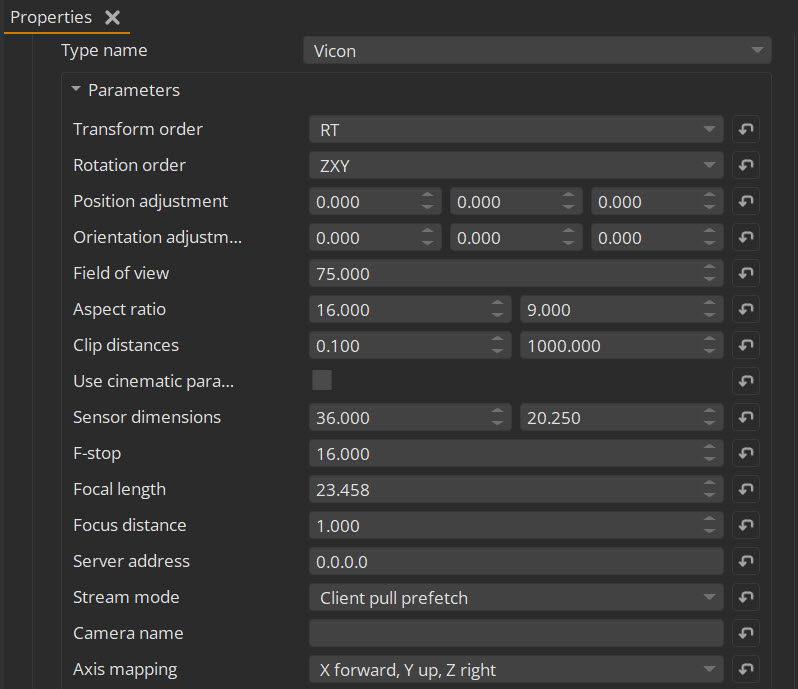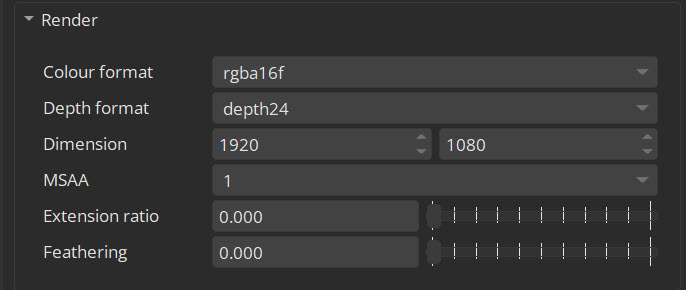Editing Camera and Cinematic Parameters
Once you choose a Stream type, you can then specify stream Parameters. Within the parameters are basic camera attributes such as Field of view, Aspect ratio and Clip Distances.
To instead use a cinematic model, click Use cinematic parameters.
When enabled, values set for Field of view, Aspect ratio and Clip Distances will be ignored. Instead the values for the parameters Sensor dimensions, F-stop, Focal length and Focus distance will be used.
You can also add offsets to add to the camera stream using Position adjustment and Orientation adjustment.

Other Camera Parameters
The Camera Parameters also contain a Render section which allows you to specify the Color format, Depth format as well as the Dimension (resolution) at which to render the camera.
For outer cameras, this defines the resolution of each side of a cube map, so the x and y values should match (e.g. 256 x 256). You can also add an Extension to the render which will extend the render by the specified percentage, which might help with inner camera latency issues. The Feathering option will add softness within the extension.

The camera parameters also contain a Debug section which enables camera borders around each camera render using the Draw border tickbox, as well as parameters for customizing that border.

There is also a Health section, where you can set the current status of the camera stream.
If you have your cameras and displays set up, you can translate and rotate them as one object within the Viewport by selecting Project Graph > Scene and using the Viewport handles.
Further information about each camera and cinematic parameters option can be found at Camera and Cinematic Controls.
FreeD Lens Data
The FreeD camera tracking implementation can receive and apply lens data as well as transformations. Incoming lens values received through FreeD will be accessible through the Focus Distance, Focal Length and F-Stop parameters. These received values are raw Encoder values which can then be mapped to lens values using a number of new parameters in the FreeD camera.
Note: To receive lens data from the FreeD packets, ensure Use FreeD lens data is ticked. If this is unticked, the lens data will be defined by the user-set parameters.
A full length of Focus Distance, Focal Length and FStop property parameters can be found at Camera and Cinematic Controls > Inputs and Controls > Additional Parameters - FreeD.
Some tips for implementing FreeD Lens Data:
• To use the incoming data for a particular lens parameter, ensure the Is Valid focus distance/ focal length/ F-Stop tickbox is checked.
• By default, the range of the incoming encoder values is defined by a dynamic range. You can set this range by turning each encoder all the way to minimum/maximum upon startup.
• If Use manual range focus distance/ focal length/ F-Stop is enabled for that lens data, the Min encoded focus distance/ focal length/ F-Stop and Max encoded focus distance/ focal length/ F-Stop parameters will be used to calculate the range instead of the dynamic one.
• After the range has been set using the dynamic or manual options, the incoming values can be taken as-is if Use camera range is unticked. If it is ticked, the values will be normalized to the user-specified Min focus distance/ focal length/ F-Stop and Max focus distance/ focal length/ F-Stop.
• There are also a number of modifiers to add offsets or multipliers to the incoming tracked lens value if needed.
The final live camera data can be viewed from the following dropdown within the camera.

